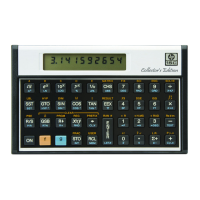Section 12: Calculating with Matrices 173
Miscellaneous Operations Involving Matrices
Using a Matrix Element With Register Operations
If a letter key specifying a matrix is pressed after any of the following
function keys, the operation is performed using the matrix element
specified by the row and column numbers in R
0
and R
1
, just as though it
were a data storage register.
O
*
l
*
O{+, -, *, ÷} l{+, -, *, ÷}
e I
X
Using Matrix Descriptors in the Index Register
In certain applications, you may want to perform a programmed sequence
of matrix operations using any of the matrices A through E. In this
situation, the matrix operations can refer to whatever matrix descriptor
is stored in the Index register (R
I
).
If the Index register contains a matrix descriptor:
Pressing % after any of the functions listed above performs the
operation using the element specified by R
0
and R
1
and the matrix
specified in R
I
.
Pressing % after O | or l | performs the operation
using the element specified by the row and column numbers in the Y-
and X-registers and the matrix specified in R
I.
Pressing ´ m V dimensions the matrix specified in R
I
according to the dimensions in the X- and Y-registers.
Pressing l m V recalls to the X- and Y-registers the
dimensions of the matrix specified in R
I
.
Pressing G V or t V has the same result as pressing
G or t followed by the letter of the matrix specified in R
I
.
(This is not actually a matrix operation—only the letter in the matrix
descriptor is used.)
*
Also, in U mode the row and column numbers in R
0
and R
1
are incremented
according to the dimensions of the specified matrix.

